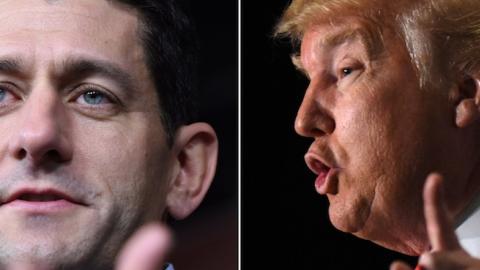Some might view House Speaker Paul Ryan’s recent endorsement of Donald Trump as evidence that opposites attract. In terms of age, demeanor, and life experiences, their differences are certainly more striking than their similarities. With a potential Trump presidency on the horizon, a key question is whether the two men’s equally stark differences on matters of policy—especially on immigration, trade, and big-government health care—could potentially prove complementary and reflect the will of GOP voters.
Although most Republican leaders seem determined not to think about it, Republican voters nearly mutinied this year over the issue of (illegal) immigration. Indeed, with Trump preparing to accept the party’s presidential nomination next month, one could argue that it wasn’t just a near-mutiny.
Even before 2016, there had been plenty of strong indications that Republican elites and Republican voters weren’t remotely on the same page on this issue: Two years ago, political novice Dave Brat not only beat House Majority Leader Eric Cantor in a historic upset but blew him out, winning by 11 points. (Brat is a gifted politician, but his win was still extraordinary.) Last year, Gallup’s polling found that 84 percent of Republicans (and 60 percent of all Americans) were “dissatisfied with the level of immigration into the country today.” Among all respondents, only 7 percent said they were “dissatisfied” and wanted “more” immigration.
We Want Immigration Under Control Already
The actual stats on immigration are striking and support the notion that the citizenry’s views, as suggested in Gallup’s polling, are actually quite reasonable: Immigrants’ percentage of the U.S. population is now 13.6 percent and rising (see table 2). Although mainstream reporting generally implies the opposite, that’s actually higher than during the immigration heydays of 1880 or 1920 (13.3 percent and 13.2 percent, respectively). It’s also up almost threefold from 1970 (4.7 percent).
Moreover, much of the immigration since 1970 has been illegal, a large reason it hasn’t led to as much assimilation as past immigration waves (although, as my Hudson Institute colleague John Fonte and his coauthor Stanley Kurtz highlight, there are other strong forces deliberately working against assimilation as well). In truth, the only other issue that could potentially have galvanized voters as much as immigration has (and it may still do so in the general election) is Obamacare. But nobody in the Republican field ran on Obamacare. (This was Ted Cruz’s fatal error.)
Some pundits continue to deny that immigration was really that big of an issue in this year’s GOP race, because exit polling found that it consistently trailed “economy/jobs,” “government spending,” and “terrorism” among the list of “issues that matter most.” But the very fact that immigration was being mentioned in the company of such huge issues—the economy, spending, security—was in itself telling. Many voters who care about immigration view it largely as an economic matter and therefore likely listed “economy/jobs” as the biggest issue.
As I wrote last year, “While Mark Zuckerberg and others lobby for increased levels of immigration while living in communities that are already essentially devoid of a middle class, Jay Cost, David Frum, and Byron York (among others) have sensibly argued that granting the wishes of Zuckerberg and Co. isn’t particularly consistent with focusing on the economic well-being of everyday Americans.”
Beyond immigration, Republican voters are skeptical of Republican elites’ widely held view that seeing “Made in China” stamped on seemingly every product sold on our shores is somehow evidence of American greatness. While everyday Republicans aren’t ready to abandon the notion of free trade, their views on the matter do seem closer to those of the American Founders than to those of Republicans dining at the Capitol Hill Club in Washington. Trump, of course, has made hay with this issue as well.
We Want Spending Curtailed, Too
At the same time, most rank-and-file Republicans care greatly about reining in federal spending. A little-noticed fact from this year’s exit polling was how much GOP voters emphasized profligate spending (and the nearly $20 trillion—and rising—in national debt it has produced). In Iowa entrance polling, Republican voters said “government spending” was the number-one issue—it even beat out “economy/jobs.” In Texas, Missouri, and Wisconsin, “government spending” finished second, losing to “economy/jobs” by less than 5 points.
So where does all of this leave us? Ryan supported the “Gang of Eight” immigration efforts (the very efforts that effectively derailed Marco Rubio’s presidential hopes). Ryan is also an unabashed champion of free trade. In other words, he is pretty close to the opposite of Trump on each of Trump’s two signature issues.
Meanwhile, Ryan has made his name by fighting runaway entitlement spending. While he has since receded into the background on Obamacare, he was once the conservative movement’s finest spokesman against it and could potentially become so again. (See the Health Summit and his speech on the night Obamacare passed the House with no bipartisan support and only three votes to spare.) His proposed Medicare reforms, a sort of “Medicare Advantage Plus,” are a crucial part of reining in federal spending and have gained the support of almost every Republican member of Congress. Trump, meanwhile, has been weaker on health-care entitlements—including, most importantly, Obamacare—than on any other domestic-policy issue.
In other words, on the major legislative issues of the day, GOP voters are in between Trump and Ryan. A sort of blend of the two men’s views would pretty closely reflect those of the Republican rank-and-file. Collectively, GOP voters are significantly closer to Trump on immigration, probably about equidistant from the two men on trade, fully in line with Ryan on the need to repeal (and replace) Obamacare, and closer to Ryan on the need to reform Medicare to rein in runaway spending.
A glass-half-full version of what a Trump presidency could look like, therefore, is that Trump would pull immigration policy well to the right of where Ryan would want it to be, the two men would moderate each other on trade, and Ryan would pull Trump far to the right on the big-government health-care programs that are centralizing power and bankrupting America. (A glass-half-empty version would entail something closer to a continuation of the unacceptable status quo on all three fronts.)
So perhaps Republican voters knew what they were doing more than the center-right punditry is willing to admit. Or perhaps the glass is really half-empty.














